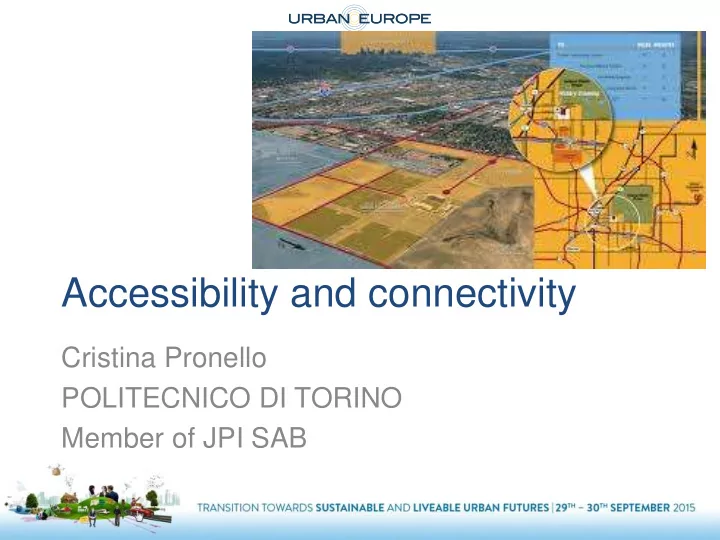

Accessibility and connectivity Cristina Pronello POLITECNICO DI TORINO Member of JPI SAB
Accessibility and connectivity: definition • Accessibility is the ease with which activities and opportunities may be reached using a transport system territorial cohesion and social exclusion.
Accessibility and connectivity: definition • Accessibility is a function of proximity to destinations and the directness of routes to those destinations network connectivity. • The decrease of the travel time and cost should not be related to allow for faster transport systems, but to more connected systems.
Accessibility and connectivity: insight • While connectivity can remain unchanged – a network connecting poles of attraction can be stable on the time – the accessibility can change because the users change (elderly people have new needs in terms of services, timetables, etc.). • Accessibility implies an economical aspect, even more during crisis periods, when getting a pass for public transport can be a barrier to accede to the system and, thus, reduce the accessibility to the transport systems. • The connectivity has social implications when social activities become mobilised in space and identify how social ties affect the integration of the transport systems into urban patterns.
Topics to be addressed Users ’ needs, behaviours and locational proximity 1. to better locate activities in cities and plan the transport system Three questions 1. What are the main reasons behind passengers ’ (and freight operators’) behaviours and their residential and mobility choices? 2. To what extent does activity location influence journey frequency and modal choice? 3. What are the potential variables supporting a shift towards more sustainable (particularly soft, or slow) modes? What is their likely effectiveness?
Topics to be addressed 2. Integration technologies Modern integrated transport systems should allow for improved accessibility through better network connectivity Five questions To what extent do ATISs change travellers ’ 1. behaviour and residential choices? 2. What are the most effective business models of sociotechnical solutions for improved mobility; including ATIS and integrated tariffs? 3. Which strategies are most effective at improving connectivity and systems (including tariff) integration? 4. How should cities monitor and continually improve upon accessibility? Are current planning and management systems sufficient or in need of reform? 5. Which policy measures are required to support more sustainable forms of mobility?
Topics to be addressed Bridging the gap between travellers’ 3. needs and behaviours connectivity and accessibility can improve social inclusion. But in less dense areas, ensuring good accessibility is challenging using alternative modes to the car, as demand for public transport may be too low to render it viable. This situation can be compounded for less able and/or less well off people, such as the elderly, who do not have access to a car One question What are the solutions, technological (e.g. driverless), social, economic, etc. to increase accessibility and connectivity in low density areas and for elderly or disabled?
Points of attention 1. Analysing transport systems through the lens of accessibility and connectivity can facilitate the joint pursuit of mobility and sustainability goals 2. This paradigmatic shift also requires an improved understanding of the sectorial changes at stake, their interrelationships and their overall effects on urban performance .
Points of discussion How will the IT- revolution affect the users’ travel 1. behaviour? 2. Which is the role of sharing economy and of mobility as a service ? 3. Is it now time to invest in better understanding what citizens/users want and how they react to urban and transport policies to readdress the mobility in the urban areas. It is time to interact with the users to better address the urban and transport planning. What is the role of the urban planners, are they in the front or the back seat? What is the role of JPI Urban Europe?
THANKS !
Recommend
More recommend